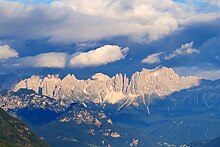King Laurin's rose garden

King Laurin is the legendary dwarf king of the rose garden who is defeated by Dietrich von Bern in the battle . The story was passed down as a Middle High German heroic epic from the 13th century and as a folk alpine legend . The latter tries to explain the red glow of a mountain region at dusk ( alpine glow ) and thus represents an etiological narrative .
Popular tradition
According to popular tradition, the "Gartl", a rubble between the top of the Rosengartenspitze , the Laurinswand and the Vajolet towers (the framed white spot in the photo above ), was the dwarf king's beautiful rose garden. When the king on the Adige wanted to marry his beautiful daughter Similde, all the aristocrats in the area were invited to a May trip, except King Laurin. He then decided to take part as an invisible guest with the help of his magic hat. When he saw Similde, he immediately fell in love with her, put her on his horse and jumped away with her. Immediately attracted the stretching out, led by Dietrich von Bern and his weapon master Hildebrand to Similde retrieve and were shortly before the rose garden.
King Laurin put on a miraculous belt that gave him the strength of twelve men and faced the battle. When he saw that he was losing in spite of everything, he put on his magic hat and, invisible as he thought he was now, jumped back and forth in the rose garden. But the knights recognized by the movements of the roses where the dwarf king was hiding. They grabbed him, destroyed the magic belt and took him prisoner. But Laurin turned around and put a curse on the rose garden that had betrayed him : neither by day nor by night should a human eye ever see him again. But Laurin has forgotten the twilight, and so it happens that the rose garden blooms at sunrise and sunset.
Another variant of the legend interprets the alpenglow as a reflection of the festivities in the sunken crystal castle of the dwarf king.
Another variant focuses on the unfaithfulness of the people in contrast to the loyalty of the dwarfs; the rose garden here is the legacy of King Laurin's late daughter.
Heroic epic
The Middle High German heroic epic version has come down to us in at least eighteen manuscripts from the beginning of the 14th to the beginning of the 16th century and eleven prints from 1479 to 1590. There is also a Czech manuscript from 1472 and a Danish adaptation. The Middle High German texts can be divided into five versions based on content and form:
- older Vulgate version (basic story)
- Younger Vulgate version (with a history of the kidnapping of Dietleib's sister)
- Walberan version (link to another story about the dwarf king Walberan)
- Dresdner Laurin (content like the older Vulgate, but stanzas in Heunenweise . All other versions in pairs of rhymes.)
- Pressburger Laurin (only a fragment until Dietrich set out for the rose garden, rather parodic description).
An essential difference between the versions can be seen in the assessment of the conflicting parties: Laurin's party is increasingly negatively identified, so that the completely unjustified destruction of the rose garden by Wittich and Dietrich takes a back seat. An exception is the Walberan version, in which the dwarf party is portrayed as just, mild and chivalrous.
Expenses (selection)
- L. Bückmann and H. Hesse: Zwergkönig Laurin: a minstrel poem from the beginning of the 13th century , Leipzig 1890 ( online ).
- G. Wood: Laurin and the little rose garden. 1897.
- K. Müllenhoff: Laurin. 1874; 5th edition 1926; Reprint 1948.
Film adaptations
- König Laurin (film) (2016), screenplay and director: Matthias Lang
literature
- Joachim Heinzle : Introduction to Middle High German Dietrichepik . De Gruyter, Berlin 1999, ISBN 3-11-015094-8 , pp. 145 ff.
- Ulrike Kindl (Ed.): Fairy tales from the Dolomites . Eugen Diederichs Verlag, Munich 1992, ISBN 3-424-01094-4
- René Wetzel: Dietrich von Bern in the "Laurin" (A) as a commuter between heroic and Arthurian world . In: Yearbook of the Oswald von Wolkenstein Society , Vol. 14, 2003/04, pp. 129–140.
- Karl Felix Wolff (ed.): Dolomite legends. Legends and traditions, fairy tales and stories of the Ladin and German Dolomite inhabitants. With two excursions, Berner Klause and Lake Garda . VA Athesia, Bozen, 2003, ISBN 88-8266-216-0 (repr. Of the Innsbruck edition 1989)
- Karl Felix Wolff: King Laurin and his rose garden. Courtly fairy tales from the Dolomites. Athesia Publishing House, Bozen 1999 (1st edition 1966), ISBN 978-88-7014-047-7 .
- Karl Felix Wolff: King Laurin and his rose garden. Based on medieval poems and various folk tales, reproduced freely and with explanations. Athesia, Bozen 1947 (3rd, significantly increased edition).
Web links
Individual evidence
- ↑ Johann Nepomuk Sepp : Old Bavarian saga treasure . Munich 1876, p. 8.
- ^ Villamaria (own Marie Timme): King Laurin . In: Elfenreigen. German and Nordic fairy tales from the realm of giants and dwarfs, elves, mermaids and goblins. Otto Spamer, Leipzig 1877, pp. 359–372.

